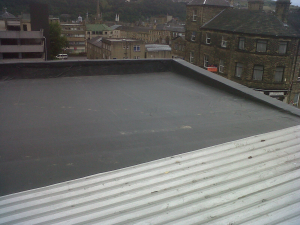What does EPDM stand for?
EPDM is a type of roofing made of rubber which is very sturdy, durable, and flexible. It has a wide variety of uses – in vehicles, cold-rooms, decks, playgrounds, and many others. More specifically, it is a synthetic rubber which is capable of retaining its strength and flexibility even amidst changes in temperature. This is one of the main reasons why EPDM is often used for outdoor applications.
EPDM is a copolymer with elastomeric properties, which means it is a polymer which is both viscous and elastic. When the material is stretched, it is still able to retain its original shape. The material is composed of 2 main components, namely ethylene and propylene, which gives it its name ethylene propylene diene monomer. Both of these components are derived from oil and natural gas sources.
Aside from ethylene and propylene, the diene monomers inside the material are responsible for the resilience, durability, as well as flexibility of EPDM materials. These monomers form the cross linking bonds that give the material these properties. Overall, the composition of EPDM roofing materials is extremely resilient against ageing.

What is EPDM Roofing?
In terms of application, however, EPDM roofing actually refers to a wide range of roofing systems. EPDM is used as a rubber membrane that is incorporated into different parts of the roofing structure. Oftentimes, these roofing systems have a single layer of the EPDM rubber, which will also be set with other materials, such as insulation layers, vapour barriers, and other roofing underlayments.
EPDM roofing, while available for use in a variety of roofing methods, is often used in forming flat or low-sloped roofs. It is a common choice because of its durability and resilience, especially against harsh weather conditions. Another advantage to using EPDM roofing is that it is easy to apply evenly on a large roof area which can prevent the formation of indentations which often leads to the formation of pools.
A few other advantageous properties of the material is that is is highly tear resistant and has a strong tensile strength which factor in to its weathering resilience. This makes it unmatched in terms of weather-resistance, which is why it is so ideally suited for roofing.
How Can EPDM Be Used?
Rubber has been applied for hundreds of years in many different methods. In the 2th century, natural rubbers were commonly used for a variety of things. However, natural rubbers are quick to degrade and are not as durable as the now commonly used synthetic rubbers. Synthetic rubbers have been made to possess qualities that make it much more durable and resistant than these natural materials we used back then.
EPDM is a synthetic rubber that was feisty used in 1962. It quickly became a staple material used in many industries. HVAC units, brake systems, insulation systems, and roofing systems have benefited immensely from this material.
The material is commonly available in a black or white option. The advantage of having a black EPDM roof is that it is better at absorbing heat which makes it an effective insulation system. Black EPDM roofs are better suited for properties in colder climates.
Should you get an EPDM roof?
When you are in the market for a new roof, you probably know by now that there are so many options to consider. With the variety of options that are readily at your feet, it can be so easy to just let your roofing contractor make the choice for you – after all, we are the experts. However, while it might seem like a good and easy choice to make, educating yourself and knowing your options will help you decide what the best option is for you and your family. It will also help you in making decisions in the future.
But if you are still having a hard time making a decision, here’s something that might make it easier for you.
Pros and Cons of EPDM Roofing
While EPDM roofs are highly durable, flexible, and resilient, there are both pros and cons when considering this material for your roof.
Pros
- Environmentally Friendly
- Durable and Long-lasting
- Resistant to Fire
- Saves Energy
Cons
- High labor and installation costs
- Vulnerable in the wrong climate
- Doesn’t seem ‘classy’
- Work with a Certified Roofing Contractor
When it comes to roofing, there are a couple DIY projects that you can take on. But, if you want to get the best out of your materials, ensuring that you are installing, replacing, or repairing the roof the right way is essential. In order to do this, it is always best to contact your local roofing contractor, especially one with years of experience like Wade Exteriors.

